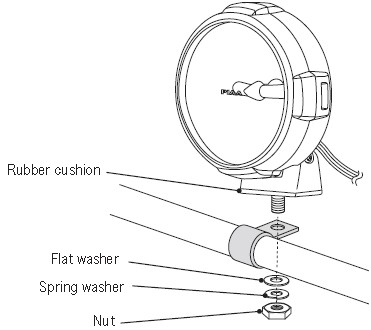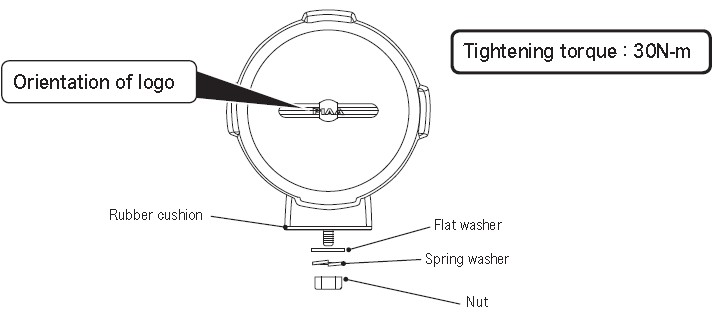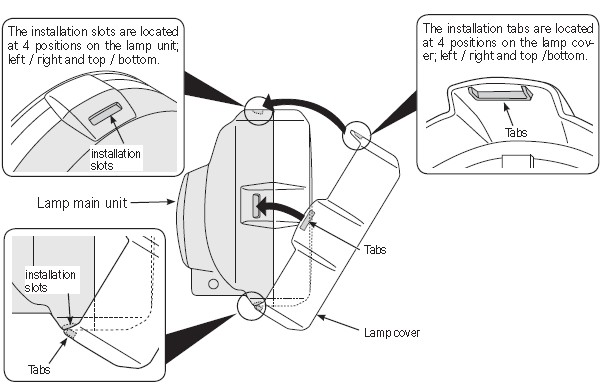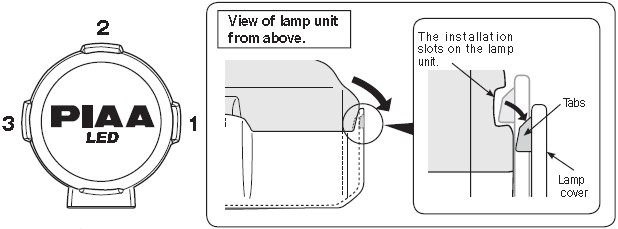
How to Install PIAA LP570 7 in. Round LED Lights - Driving Beam - Pair on your F-150
1. Lamp installation
For lamp installation, a hole with a diameter of 12mm is required. Make necessary preparation such as installation of lamp bracket.

• When using a commercially supplied lamp bracket, before removing the bolt that is already installed on the car body, make sure that it is safe to do so.
• The lamp should be mounted in an area sufficient to support its size and weight.
Failure to do so may result in excess vibration leading to shorter bulb life and or physical damage to the lamp or your vehicle.
• Do not attempt to install the lamp directly to any plastic part of the car body.
If the lamp needs to be installed on the plastic reinforcement materials should be placed on both sides of the plastic part.
• When installing, make sure the lamp body, lens and rim are not touching the bumper and other plastic parts. Such plastic parts might deform.
• The lamp installation surface should be flat.

The lamp should be tightened to the degree that the lamp body cannot be moved by hand.
2. Relay Harness Installation Sequence

3. Procedures for Installing / Removing the lamp cover
When using the lamp for extended periods of time, we recommend that a lamp cover be used over the main lamp unit in order to prevent undue damage.
For installing the lamp cover, first take the small tab on the upper edge of the cover and line it up with the slot on lamp unit and snap it in place. Then continue to snap the remaining tabs in place.

For removing the lamp cover shown in figure 1.2 below, take one tab on the lamp cover and lift it over the slot on the lamp unit, then continue with the remaining 3 tabs.

CAUTION
The lamp cover is structurally built so that it does not come loose while the vehicle is in motion. Therefore, be extremely careful when removing and installing the lamp cover as it is a very tight fit.
DRIVING / Spot Light Aiming
Typically, driving lights are mounted above the front bumper about 14 cm -30 inches from the ground to provide extra high beam illumination. Driving lights can be mounted below the bumper, although they will not be as effective because the light will hit the ground sooner and reduce the range of the light.
Visual aim is made with the center of the beam hot spot 1.5 inches below the lamp center at 25feet with the lamp facing straight forward. (see below.)
CAUTION
● Do not use driving lights into oncoming traffic.
Driving lights should neverbe the only forward light source. Driving lights should only be used with the headlamp high beams.

4. Troubleshooting
1 After installation, if the lamp does not activate
→ Check the wiring and make sure there are no faulty or irregular connections .
● If the switch illumination does not light up.
→ Verify the ( ) wire from the switch is properly connected. If it is not correctly connect it will not activate.
→ Verify the fuse located on the vehicle' s wiring system. (the switch' s ( ) wire should be connected to the fuse box). If it is burned out, connect it to another circuit.
→ Check the fuse for the relay harness. If it is burned out, follow instructions indicated in [ 3 Fuse replacement Procedures].
● The switch illumination lights up but when operating it an audible “click” is not heard.
→ If the switch itself is faulty, the same symptoms may exist. We recommend that the entire switch unit be replaced.
● The switch illumination lights up but when operating it an audible “click” can be heard.
→ Check the bulb. If it is burned out replace it accordingly.
2 If the bulb suddenly fails to light up ...
→ Check the bulb inside the housing and if it is burned out replace accordingly.
→ Check the fuse located in the vehicle. If it is burned out, replace accordingly.
→ Check the fuse for the relay harness. If it is burned out, follow instructions indicated in [ 3 Fuse replacement Procedures].
→ There may be cases where each terminal related to specific sections may be incorrectly connected. Check for any lose wires and also for dirt or grime.
→ Water or incorrect connection may cause an irregular electric current flow, which could damage the relay. Replace the relay and check each section of the relay installation position and wiring.
→ Check the switch. If an abnormality is found, replace it accordingly.
3 Fuse replacement Procedures
→ A short circuit may have occurred. Check the lamp interior and wiring system. If any type of damage is found replace accordingly. (Non-replacement may pose a potential danger) (Short circuits are mainly caused when wires are caught in the assembly or when there is a gap in the sleeve connected to the lamp harness. Be extremely careful when reassembling the lens unit or replacing a bulb.
→ Verify the wattage capacity of the relay harness is accurate. Using a bulb that exceeds the relay harness wattage can be potentially dangerous. Always use bulbs that correspond to the wattage specified.

